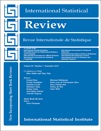Archive
Pre-data insights update priors via Bayes’s theorem
D. R. Bickel, “Bayesian revision of a prior given prior-data conflict, expert opinion, or a similar insight: A large-deviation approach,” Statistics 52, 552-570 (2018). Full text | 2015 preprint | Simple explanation
Inference to the best explanation of the evidence
The p value and Bayesian methods have well known drawbacks when it comes to measuring the strength of the evidence supporting one hypothesis over another. To overcome those drawbacks, this paper proposes an alternative method of quantifying how much support a hypothesis has from evidence consisting of data.
D. R. Bickel, “The strength of statistical evidence for composite hypotheses: Inference to the best explanation,” Statistica Sinica 22, 1147-1198 (2012). Full article | 2010 version
The special law of likelihood has many advantages over more commonly used approaches to measuring the strength of statistical evidence. However, it only can measure the support of a hypothesis that corresponds to a single distribution. The proposed general law of likelihood also can measure the extent to which the data support a hypothesis that corresponds to multiple distributions. That is accomplished by formalizing inference to the best explanation.
Empirical Bayes single-comparison procedure
D. R. Bickel, “Small-scale inference: Empirical Bayes and confidence methods for as few as a single comparison,” International Statistical Review 82, 457-476 (2014). Published version | 2011 preprint | Simple explanation (link added 21 June 2017)
Parametric empirical Bayes methods of estimating the local false discovery rate by maximum likelihood apply not only to the large-scale settings for which they were developed, but, with a simple modification, also to small numbers of comparisons. In fact, data for a single comparison are sufficient under broad conditions, as seen from applications to measurements of the abundance levels of 20 proteins and from simulation studies with confidence-based inference as the competitor.
Optimal strength of evidence
D. R. Bickel, “Minimax-optimal strength of statistical evidence for a composite alternative hypothesis,” International Statistical Review 81, 188-206 (2013). 2011 version | Simple explanation (added 2 July 2017)
This publication generalizes the likelihood measure of evidential support for a hypothesis with the help of tools originally developed by information theorists for minimizing the number of letters in a message. The approach is illustrated with an application to proteomics data.
Confidence levels as degrees of belief
D. R. Bickel, “A frequentist framework of inductive reasoning,” Sankhya A 74, 141-169 (2013). published version | 2009 version  | relationship to a working paper | simple explanation (added 17 July 2017)
| relationship to a working paper | simple explanation (added 17 July 2017)
A confidence measure is a parameter distribution that encodes all confidence intervals for a given data set, model, and pivot. This article establishes some properties of the confidence measure that commend it as a viable alternative to the Bayesian posterior distribution.
Confidence (correct frequentist coverage) and coherence (compliance with Ramsey-type restrictions on rational belief) are both presented as desirable properties. The only distributions on a scalar parameter space that have both properties are confidence measures.
Confidence-based decision theory
D. R. Bickel, “Coherent frequentism: A decision theory based on confidence sets,” Communications in Statistics – Theory and Methods 41, 1478-1496 (2012). Full article (open access) | 2009 version | Simple explanation (link added 27 June 2018)
To combine the self-consistency of Bayesian statistics with the objectivity of frequentist statistics, this paper formulates a framework of inference for developing novel statistical methods. The framework is based on a confidence posterior, a parameter probability distribution that does not require any prior distribution. While the Bayesian posterior is defined in terms of a conditional distribution given the observed data, the confidence posterior is instead defined such that the probability that the parameter value lies in any fixed subset of parameter space, given the observed data, is equal to the coverage rate of the corresponding confidence interval. Inferences based on the confidence posterior are reliable in the sense that the certainty level of a composite hypothesis is a weakly consistent estimate of the 0-1 indicator of hypothesis truth. At the same time, the confidence posterior is as non-contradictory as the Bayesian posterior since both satisfy the same coherence axioms. Using the theory of coherent upper and lower probabilities, the confidence posterior is generalized for situations in which no approximate or exact confidence set is available. Examples of hypothesis testing and estimation illustrate the range of applications of the proposed framework.
Additional summaries appear in the abstract and in Section 1.3 of the paper.
Observed confidence levels for microarrays, etc.
D. R. Bickel, “Estimating the null distribution to adjust observed confidence levels for genome-scale screening,” Biometrics 67, 363-370 (2011). Abstract and article | French abstract | Supplementary material | Simple explanation
This paper describes the first application of observed confidence levels to data of high-dimensional biology. The proposed method for multiple comparisons can take advantage of the estimated null distribution without any prior distribution. The new method is applied to microarray data to illustrate its advantages.







You must be logged in to post a comment.